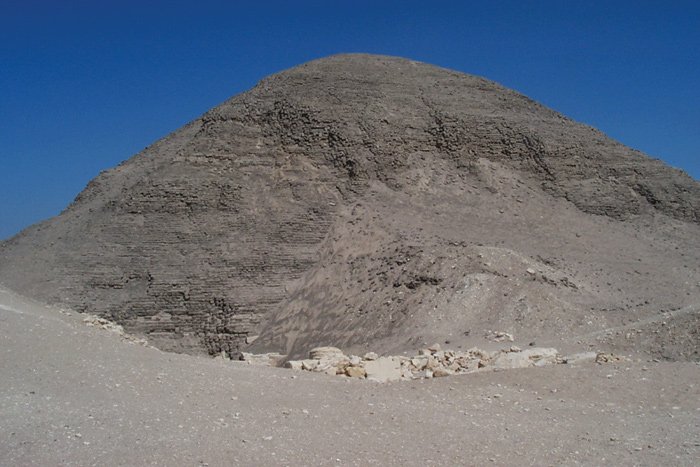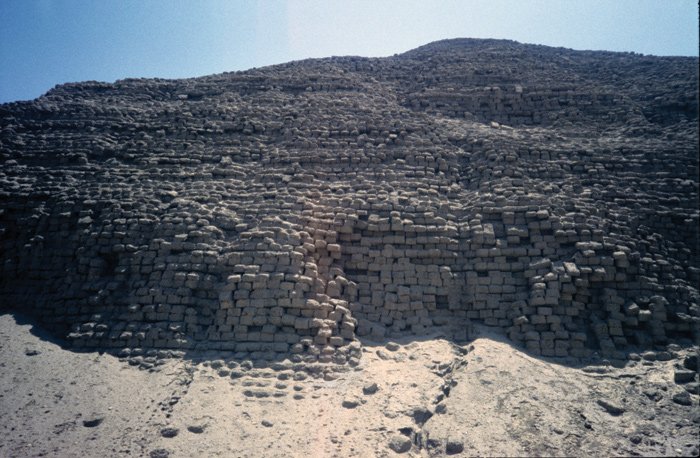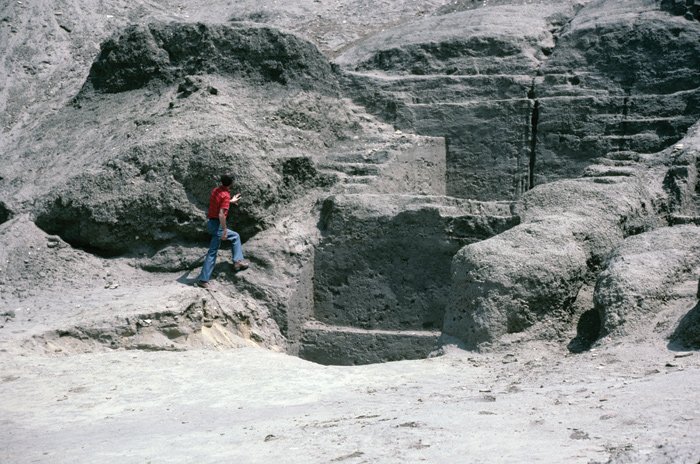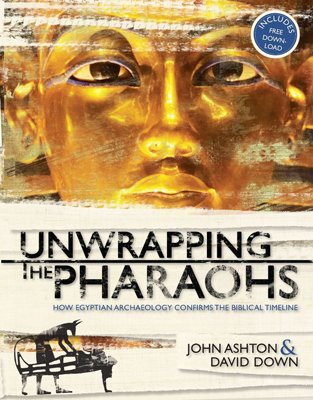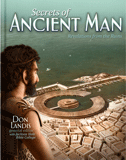
Chapter 12
Pharaohs of the Oppression
Pharaoh Sesostris III was the fifth king of the 12th Dynasty of Egypt and he erected a pyramid at Dahshur, 18.6 miles (30 km) south of Cairo, for his burial.
This pyramid was entered by tomb robbers, probably soon after his burial, and they looted all the treasures that they could find, but there were some treasures that they did not find.

Amenemhet III built two pyramids, one at Hawarra and the other, shown here, at Dahshur. He was the last great pharaoh of Dynasty 12 and may well have been the foster father of Moses.
Recently, a team from the Metropolitan Museum of New York was doing some research in the pyramid, and they discovered a secret niche at the side of one of the passages, not far from the queen’s burial chamber beneath the pyramid. In the niche they found some rich jewelry inscribed with the name of Queen Nefret, the mother of Sesostris III and wife of his predecessor, Sesostris II. In the cache were gold brooches, necklaces, pendants inlaid with cornelian, two gold lockets shaped like lions, and two blue amethyst scarabs.
Robert Delia has written an interesting article about Sesostris III in KMT (A Modern Journal of Ancient Egypt).1 Justifiably, Robert refers to him by his Egyptian name, Senwosret III, though due to the absence of vowels in the hieroglyphs, his name may be spelled differently by some other scholars. Sesostris is the Greek name given him by the Egyptian priest Manetho, writing in the third century B.C. Senwosret means “man of power.”
According to Robert Delia, Sesostris was indeed a man of power, though two other kings of the 12th Dynasty also bore that name. Sesostris III waged many battles against the Nubians in the south and possibly against the Canaanites in the north. One of his army officers claimed that he captured a district called SKKM, which Robert thinks might have been Shechem, when “his majesty proceeded northwards to overthrow the Beduin of Asia.”

Sesostris III was a disagreeable-looking pharaoh and should be identified as one of the pharaohs of the oppression.
Sesostris left many statues of himself, and Robert has not failed to notice a marked characteristic of this pharaoh. Most pharaohs were pleased to have their sculptors depict them to the best advantage. Whatever they actually looked like, they are shown as noble and good looking. Not so for Sesostris. Not only was he a tough-looking guy, he obviously instructed his sculptors to “tell it as it is.”
His statues show him with a sour face whose mouth is turned down at the corners. Robert notes this and refers to “the severity of Senwosret’s facial features,” the “naturalism” of his statues. “Besides the ever-present protruding ears, the older portrayals show deep vertical creases above the roots of the nose, greatly accentuated pouches under the eyes, pronounced lines from the inner corners of the eyes, and dramatically down-turned mouths.”2 This is in marked contrast to the statues of Sesostris I, who has quite a pleasant expression, almost a smile, on his face.
The texts of Sesostris III reveal him as a strong-minded character who burned the crops of his enemies. On the Semna stela he wrote:
“I made my boundary, I went further south than my forefathers. I increased what was bequeathed to me. . . . I am a king who speaks and acts. My heart’s intentions are carried out by my arm. I am one who is aggressive in order to seize, impatient to succeed, and who does not allow a matter to lie in his heart. . . . Aggression is valor while retreat is cowardice.”
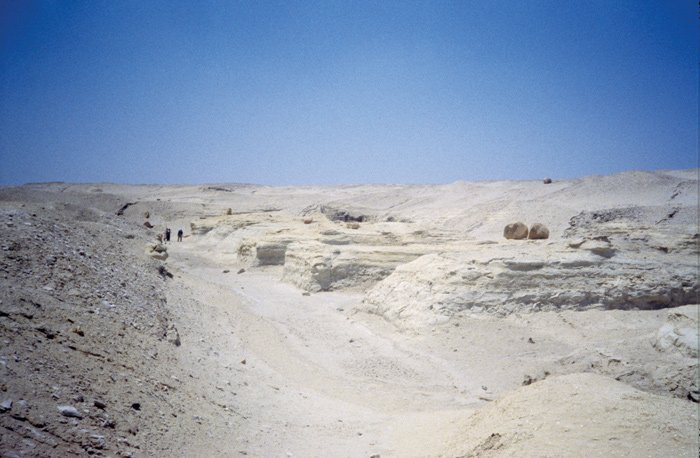
The pyramid of Sesostris II at Lahun adjoins the city of Kahun where the workmen who built the pyramids of Dynasty 12 lived. At the rear of his pyramid are these mastabas which were hewn out of the solid rock.
The dates assigned to the Middle Kingdom by Dr. Rosalie David are 1991-1786 B.C.3 This would place Sesostris III about 1840 B.C. However, some scholars recommend a later date. Biblical chronology places the Exodus about 1445 B.C. (1 Kings 6:1). This could place the beginning of the oppression about 1600 B.C., and if the beginning of the reign of Sesostris III was reduced to this time, then he would have been the pharaoh who oppressed the Israelite slaves. His statues and texts indicate that he was the type of tyrant who would be quite capable of such cruelty.
Significantly, he was responsible for a lot of building activity in the delta where Israelite slaves were put to work. Robert specifically mentions Bubastis, Tanis, and Qantir, the biblical Raamses.4 “And they built for Pharaoh supply cities, Pithom and Raamses” (Exodus 1:11).
The archaeological evidence supports the idea of Semitic slavery during the latter half of the 12th Dynasty. Sir Flinders Petrie excavated a city called Kahun in the Faiyum, an important center of activity during the 12th Dynasty. His finds were recorded in a book written by Dr. Rosalie David, who is in charge of the Egyptian department of the Manchester Museum where Petrie lodged most of his finds.

A sphinx of Amenemhet III who had two daughters but probably no sons to inherit his throne. This may explain why he would accept Moses as the future heir.
She wrote:
“It is apparent that the Asiatics were present in the town in some numbers, and this may have reflected the situation elsewhere in Egypt. It can be stated that these people were loosely classed by Egyptians as ‘Asiatics,’ although their exact homeland in Syria or Palestine cannot be determined. . . .The reason for their presence in Egypt remains unclear.”5
The reason for this uncertainty is because of the wrong date usually assigned to this era. If this period is recognized as contemporary with the period of Israelite slavery in Egypt, the origin of these people and how they came to be in Egypt will be easily understood.
“The children of Israel were fruitful and increased abundantly, multiplied and grew exceedingly mighty and the land was filled with them. Now there arose a new king over Egypt who did not know Joseph, and he said to his people, ‘Look, the people of the children of Israel are more and mightier than we; come and let us deal shrewdly with them. . . .Therefore they set taskmasters over them to afflict them with their burdens. . . . And they made their lives bitter with hard bondage’” (Exodus 1:7-14).
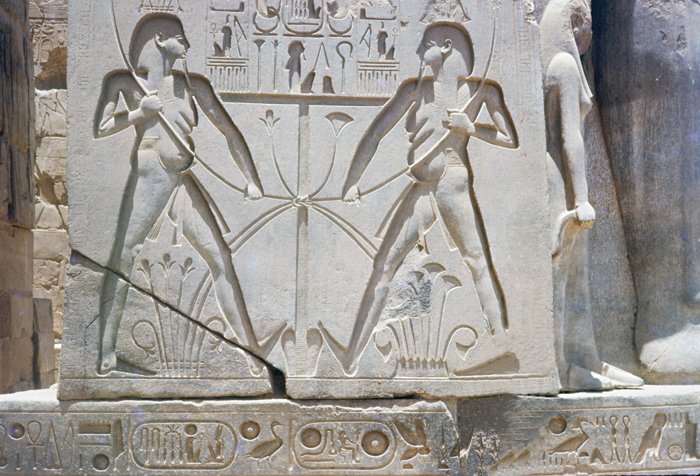
The Nile god Hapy, tying Upper and Lower Egypt together, was the fertility god, just the deity Pharaoh’s daughter needed when she was praying for a son.
One line of evidence for the presence of these Asiatic slaves was in a papyrus which was left to the Brooklyn Museum. In this papyrus,
“a woman named Senebtisi attempts to establish her legal rights to the possession of ninety-five servants. . . . Of the seventy-seven entries which are presented well enough to enable the individual’s nationality to be read, twenty-nine appear to be Egyptian while forty-eight are ‘Asiatics.’ Although the foreign names were not precise enough to enable the exact homeland of these Asiatics to be identified, it can be said that they were from a ‘Semitic group of the northwest.’ . . . It is apparent that Asiatic servants were by now disseminated throughout the community.”6
Again she wrote, “The scattered documentation gives no clear answer as to how or why the Asiatics came to Egypt in the Middle Kingdom. . . . There is nevertheless firm literary evidence that Asiatic slaves, women and children were at Gurob.”7
According to Exodus 2:5–10,
“The daughter of Pharaoh came down to bathe at the river. And her maidens walked along the riverside; and when she saw the ark among the reeds, she sent her maid to get it. And when she had opened it she saw the child, and behold, the baby wept. So she had compassion on him, and said, ‘This is one of the Hebrews’ children.’ . . . And the child grew, and she brought him to Pharaoh’s daughter, and he became her son. So she called his name Moses saying, ‘Because I drew him out of the water.’”

An relief on the wall of the temple of Rameses II at Abydos depicts the river Nile god Hapy who binds Upper and Lower Egypt together, and supplies the luxuries of life to the people of Egypt.
Many consider it an implausible story. They question the possibility of an Egyptian princess adopting a slave child and proposing to make him the next pharaoh. Others have regarded it as factual and have tried to locate it in its historical setting. Dr. Siegfried Horn of Andrews University, Michigan, claimed that Queen Hatshepsut of the 18th Dynasty was the said princess.8
Matching the biblical date of the Exodus, about 1445 B.C., with the usually accepted date for the 18th Dynasty would produce an approximate synchronism, but the known historical facts do not fit the story. When the husband of Hatshepsut, Thutmosis II, died prematurely, his son by a secondary wife was immediately crowned as Pharaoh Thutmosis III. On Hatshepsut’s death Thutmosis assumed the throne and became the greatest pharaoh that ever ruled the land of Egypt. There was no place for Moses. However, recently some scholars have challenged the standard Egyptian chronology and called for a revised dating that would locate the Moses story in the 12th Dynasty. The most likely contender for the princess who adopted Moses would be Sobekneferu, the daughter of Amenemhet III.
Amenemhet III had two daughters, but no sons have been positively identified. Amenemhet IV has been suggested as a son of Amenemhet III, but he could just as plausibly be recognized as the son of Sobekneferu. He is a mysterious figure who may have been a co-regent of Amenemhet III or even Sobekneferu. Dr. Donovan Courville questions whether he should be identified as Moses, the foster son of Sobekneferu.9
Josephus wrote, “Having no child of her own . . . she thought to make him her father’s successor.”10 Certainly there seems to be no historical record of her having a son. When her father died she assumed the throne and ruled for only four years. Having no heir, the dynasty came to an end and was replaced by the 13th Dynasty.
If Sobekneferu was the foster mother of Moses, the circumstances seem to fit the story. She would not have been down by the riverside taking a bath because she had no bathroom in the palace. However, the river god Hapy was the fertility god of Egypt and she would more likely have been down there observing a religious ritual, praying to the fertility god for a baby. The appearance of the beautiful Hebrew babe would seem like an answer to her prayers.
Amenemhet probably ruled for 46 years. If Moses was born near the beginning of his reign, he would have fled from Egypt 40 years later, near the end of his reign. Moses showed his sympathy for the Israelites by murdering an Egyptian taskmaster who was flogging an Israelite. “When Pharaoh heard of this matter, he sought to kill Moses. But Moses fled from the face of Pharaoh and dwelt in the land of Midian” (Exodus 2:15).
If Sobekneferu was Moses’ foster mother, she was certainly well qualified to fill the role. She was one of Egypt’s few reigning queens and set the pace for the famous Queen Hatshepsut. Writing in KMT, 1998 spring edition, Dr. Gae Callender of Sydney’s Macquarie University has presented a well-researched article on Sobekneferu.11 An alternative spelling is Sebeknefrure. Gae Callander admits that “frankly, very little is known about Sobekneferu’s reign,” but then proceeds to delineate a lot of interesting material on this remarkable queen. The writer is understandably vague about the relationships of these last monarchs of the 12th Dynasty. “Sobekneferu may have been a sister or half-sister of Amenemhet IV, whose reign lasted just over nine years. He perhaps shared a co-regency of an uncertain length with Amenemhet III.” The name Sobekneferu means “the beauties of Sobek,” the crocodile god. The rulers of the 12th Dynasty established a religious and economic center in the Faiyyum Oasis where the crocodiles were nurtured and worshiped.
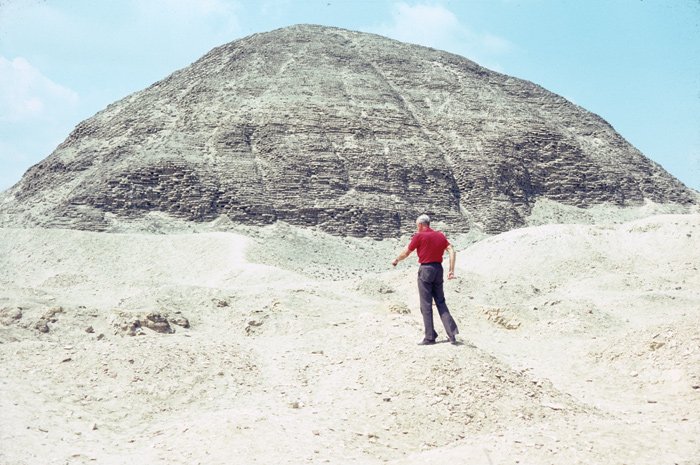
David Down at the site where Sir Flinders Petrie had great difficulty finding the burial chamber beneath the pyramid of Amenemhet III.
Sobekneferu left very few known statues of herself, and none of them are complete. Three life-sized basalt statues of her were found in the delta at Tel el Daba, but they were all headless and they were subsequently lost. Unfortunately, no one knows where they are today. In 1973, the Louvre in Paris purchased a large reddish statue of Sobekneferu which has no arms, legs, or head. When complete it would have stood 63 inches (1.6 m) tall.
Queen Hatshepsut presented herself as a male pharaoh, but she was not the first queen to have done so. In the British Museum is a cylinder seal of Sobekneferu. It gives her Horus name in a masculine form. In a glorious mixture of gender, she also refers to herself as “She whose appearance is stable, king of Upper and Lower Egypt, Sobekneferu of Shedet, she lives.” Her prenomen was “Son of Re, Sobekneferu.” In another conglomeration of sexes, the statue in the Louvre depicts her wearing a male kilt worn over a female shift. No wonder Gae Callender commented, “To put it simply, Sobekneferu may have been uncertain exactly what sex she should be for the official record.”12

Close examination of the bricks in the pyramid of Amenemhet III reveals that straw was mixed in with the mud to hold the bricks together.
The four statues referred to above have no heads, so her facial appearance cannot be determined from these, but Dennis Forbes, the editor of KMT, speculates on the possibility of another statue belonging to Sobekneferu.13 Dr. Dorothea Arnold of New York’s Metropolitan Museum commented on a head that is in that museum. It has a beautiful young face and had been assumed to belong to Amenemhet III, but as it has no inscribed name, it may be the head of Sobekneferu. Amenemhet III left many statues of himself, but they all depict him as a sourfaced monarch with appropriate features for a pharaoh who cruelly enslaved the Israelites. This other statue bears no resemblance to Amenemhet III, and may better be attributed to Sobekneferu.
Amenemhet III built two pyramids for himself, one at Dahsur and the other at Hawarra in the Faiyyum. The latter was built of sun-dried mud bricks, and the outside was faced with smooth white stones. The stones were long ago pilfered, leaving this massive pile of mud bricks. Israelite slave labor would have been used to build this pyramid. When the Israelite supervisors complained to Pharaoh about the severity of their tasks, Pharaoh replied, “You shall no longer give the people straw to make brick as before. Let them go and gather straw for themselves” (Exodus 5:7).
Petrie spent months looking for the entrance to this pyramid, which he unexpectedly found on the south side instead of on the traditional north side. It was also unusual in that it commenced with a vertical shaft, at the bottom of which a passage led to the tomb chamber. Petrie was a dedicated archaeologist and was willing to take any risk to achieve his goals. His description of his search for the tomb chamber of this pyramid reveals the conditions under which some of these early discoveries were made.
After a further search on all the four sides for the entrance, the masons attacked the sloping stone roof, and in two or three weeks’ time a hole beneath them was reported; anxiously I watched them enlarge it until I could squeeze through, and then I entered the chamber above the sepulchre; at one side I saw a lower hole, and going down I found a broken way into the sand-stone sepulchre, but too narrow for my shoulders. After sounding the water inside it, a boy was put down with a rope-ladder; and at last, on looking through the hole, I could see by the light of his candle the two sarcophagi, standing rifled and empty. In a day or two we cleared away the rubbish from the original entrance passage to the chamber, and so went out into the passages, which turned and wandered up and down. These were so nearly choked with mud, that in many parts the only way along them was by lying flat, and sliding along the mud, pushed by fingers and toes. In this way, sliding, crawling, and wading, I reached as near to the outer mouth of the passage as possible, and then by measuring back to the chamber, the position of the mouth on the outside of the pyramid was pretty nearly found. But so deep was it under the rubbish, and so much encumbered with large blocks of stone, that it took about a fortnight to reach it from the outside.14
Adjacent to this pyramid was the famous Labyrinth also believed to have been built by Amenemhet III. Practically nothing remains of it today, but Herodotus ranked it as one of the wonders of the ancient world. He says:
“I have seen this building, and it is beyond my power to describe. It must have cost more in labour and money than all the walls and public works of the Greeks put together-though no one will deny that the temples of Ephesus and Samos are remarkable buildings. The pyramids too are astonishing structures, each one of them equal to many of the most ambitious works of Greece; but the labyrinth surpasses them all. . . . Inside, the building is of two storeys and contains three thousand rooms, of which half are underground, and the other half directly above them. … It is hard to believe that they are the work of men; the baffling and intricate passages from room to room and from court to court were an endless wonder to me.”15
When Amenemhet died, his daughter, Sobekneferu, succeeded him, but she only ruled for four years, and with her death came the end of the 12th Dynasty. There was no royal successor to ascend the throne and it was left to the 13th Dynasty to fill the vacuum.
Unwrapping the Pharaohs
Adults and children alike are fascinated by Egyptian civilization. But most modern archaeologists have lately tried to use Egyptian chronology to dispute the biblical record. Secular textbooks and videos challenge the faith of students and discredit the biblical account of Exodus. Those who wish to defend the accuracy of the Bible now have an incredible tool in this exciting book that provides compelling confirmation of the biblical account.
Read Online Buy BookFootnotes
- Robert D. Delia, “Khakaure Senwosret III King and Man,” KMT (A Modern Journal of Ancient Egypt), vol. 6, no. 2 (1995): p. 18-33.
- Ibid., p. 29.
- A. Rosalie David, The Egyptian Kingdoms (New York: Elsevier Phaidon, 1975), p. 8.
- Delia, “Khakaure Senwosret III King and Man,” p. 30.
- David, The Pyramid Builders of Ancient Egypt: A Modern Investigation of Pharaoh’s Workforce (London: Guild Publishing, 1986), p. 191.
- Ibid., p. 188-189.
- Ibid., p. 192.
- Siegfried H. Horn, The Spade Confirms the Book (Washington, DC: Review and Herald Publishing Association, 1975), p. 96-97.
- Courville, The Exodus Problem and Its Ramifications, p. 221.
- William Whiston, translator, Josephus’ Complete Works (London: Pickering and English Ltd., 1963), Antiquities of the Jews, Book II, chapter IX, para. 7.
- Gae Callender, “What Sex Was King Sobekneferu?” KMT (A Modern Journal of Ancient Egypt), vol. 9, no. 1 (1998): p. 45-56.
- Ibid.
- Dennis C. Forbes, “Another Sobekneferu?” KMT (A Modern Journal of Ancient Egypt), vol. 9, no. 1 (1998): p. 55.
- Petrie, Ten Years’ Digging in Egypt, p. 85.
- Herodotus, The Histories, p. 188-189.
Recommended Resources

Answers in Genesis is an apologetics ministry, dedicated to helping Christians defend their faith and proclaim the good news of Jesus Christ.
- Customer Service 800.778.3390
- © 2024 Answers in Genesis

